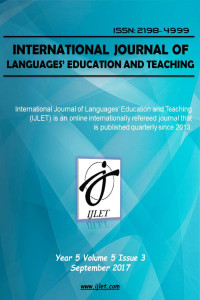Revealing to Translate: The Intertextuality and Strategic Nature of Voices, Presuppositions and Metadiscourse in a Non-Literary Text
Öz
Reading a literary text might be considered to be mostly based on reading the implicit, the inferential, the implicative, and the inarticulate, rather than the explicit, the obvious, or the outspoken. Beyond what is apparent on the surface, the text of a literary work usually has equivoques, metaphors, symbols, enigmas, undertones, implications, inferential components, and different kinds of involvements and complications as well as intertextual aspects and the difference between appearance, perception, and reality. Translating a text requires, above all, comprehending it, and various applications of analysis are employed in this respect. Although a non-literary text is not usually expected to have as many pieces to put together or variables and constituents to bring to light as a literary one, it still needs to be read critically; the characters and the voices in it need to be identified and canvassed. In addition, the degree of responsibility that the writer assumes or avoids in each part of the text needs to be detected. Analysis becomes particularly significant when translation is in question because to be able to fully reflect the source text’s particularities in the translated text, the translator needs to discover its singularity and specifications with its strategic and purposeful elements. Teaching by Principles: An Interactive Approach to Language Pedagogy by H. Douglas Brown is a textbook written for “prospective and new teachers who need to learn how to walk into a classroom and effectively accomplish communicative objectives” (Brown, 2000: xi-xii). Throughout the book’s section entitled Cheating in the chapter concerning classroom management, the existence of the implicit in a non-literary texts is pinpointed using the concepts of presupposition and metadiscourse as discussed by Norman Fairclough within the framework of intertextuality. In addition, characters and voices in the text are examined. The instances of the occurrence of these elements of analysis are treated along with the text’s coherence within itself in the presence of all those components. Furthermore, the importance of a translation-oriented analysis for the meaning of the target text is underscored with an emphasis on the prevention of unintended transformations of the meaning.
Anahtar Kelimeler
Translation-oriented critical reading and analysis Voice Presupposition Metadiscourse Norman Fairclough
Kaynakça
- Bartu, H. (2002). A Critical Reading Course. İstanbul: Boğaziçi University Press.
- Brown, H. D. (2000). Teaching by Principles: An Interactive Approach to Language Pedagogy. (2nd ed.). London: Longman.
- Cambridge Dictionary. http://dictionary.cambridge.org
- Cavender, N. & Kahane, H. (2010). Logic and Contemporary Rhetoric. The Use of Reason in Everyday Life. (11th ed.). Belmont: Wadsworth Cengage Learning.
- English Oxford Living Dictionaries. https://en.oxforddictionaries.com
- Fairclough, N. (2006). Discourse and Social Change. (12th ed.). Cambridge: Polity Press.
- Kerbrat-Orecchioni, C. (1998). L’Implicite. (2nd ed.). Paris: Armand Colin.
- Kurland, D. Dan Kurland’s www.criticalreading.com. Reading and Writing Ideas As Well As Words. http://www.criticalreading.com/inference_reading.htm
- Nord, C. (2005). Text Analysis in Translation. Theory, Methodology, and Didactic Application of a Model for Translation-Oriented Text Analysis. (2nd ed.). Amsterdam: Rodopi.
- Öztürk Kasar, S. (2009). “Pour une Sémiotique de la Traduction”. In C. Laplace, M. Lederer, D.Gile (Eds). La Traduction et ses Métiers. Caen: Lettres Modernes Minard.
Revealing to Translate: The Intertextuality and Strategic Nature of Voices, Presuppositions and Metadiscourse in a Non-Literary Text
Öz
Anahtar Kelimeler
Translation-oriented critical reading and analysis Voice Presupposition Metadiscourse Norman Fairclough
Kaynakça
- Bartu, H. (2002). A Critical Reading Course. İstanbul: Boğaziçi University Press.
- Brown, H. D. (2000). Teaching by Principles: An Interactive Approach to Language Pedagogy. (2nd ed.). London: Longman.
- Cambridge Dictionary. http://dictionary.cambridge.org
- Cavender, N. & Kahane, H. (2010). Logic and Contemporary Rhetoric. The Use of Reason in Everyday Life. (11th ed.). Belmont: Wadsworth Cengage Learning.
- English Oxford Living Dictionaries. https://en.oxforddictionaries.com
- Fairclough, N. (2006). Discourse and Social Change. (12th ed.). Cambridge: Polity Press.
- Kerbrat-Orecchioni, C. (1998). L’Implicite. (2nd ed.). Paris: Armand Colin.
- Kurland, D. Dan Kurland’s www.criticalreading.com. Reading and Writing Ideas As Well As Words. http://www.criticalreading.com/inference_reading.htm
- Nord, C. (2005). Text Analysis in Translation. Theory, Methodology, and Didactic Application of a Model for Translation-Oriented Text Analysis. (2nd ed.). Amsterdam: Rodopi.
- Öztürk Kasar, S. (2009). “Pour une Sémiotique de la Traduction”. In C. Laplace, M. Lederer, D.Gile (Eds). La Traduction et ses Métiers. Caen: Lettres Modernes Minard.
Ayrıntılar
| Birincil Dil | İngilizce |
|---|---|
| Konular | Çeviribilim |
| Bölüm | Araştırma Makalesi |
| Yazarlar | |
| Yayımlanma Tarihi | 30 Eylül 2017 |
| Yayımlandığı Sayı | Yıl 2017 Cilt: 5 Sayı: 3 |


